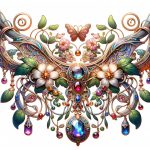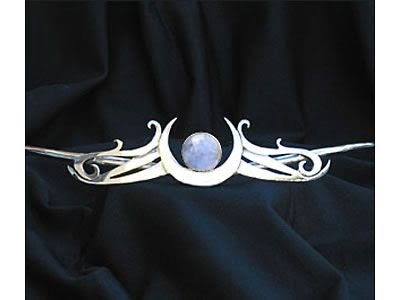In the realm of jewelry design, few styles encapsulate the fusion of artistic expression and natural beauty as elegantly as Art Nouveau. Emerging in the late 19th to early 20th centuries, Art Nouveau was a cultural movement that transcended traditional boundaries, particularly through its captivating approach to jewelry.
Known for its intricate designs and bold embrace of nature, this style has since become a timeless symbol of innovation and creativity. Art Nouveau jewelry: the intersection of art and nature is immediately evident in each piece, which often features harmonious lines and an organic aesthetic.
The origins of Art Nouveau can be traced back to the fin de siècle period (roughly 1890-1910), a time marked by dramatic social, political, and technological changes. It was during this era that artists sought to break free from the rigid conventions of academic art.
Inspired by contemporary movements such as Symbolism and Arts and Crafts, they delved into new realms of artistic expression. In particular, jewelry designers drew inspiration from the natural world around them-an ethos that resonated deeply with a society transitioning into modernity yet longing for the organic stability found in nature.
Defining characteristics of Art Nouveau jewelry include fluid lines that mimic natural forms like flowing water or undulating leaves. These pieces often feature botanical motifs such as florals, vines, and insects rendered with astonishing realism and emotional depth.
Materials were chosen not merely for their value but for their ability to complement these organic shapes; vibrant enamels, luminous glassworks, and semi-precious stones became staples in an artist’s palette. Through thoughtful design and unparalleled craftsmanship, Art Nouveau successfully merged fine art with applied arts-transforming everyday objects like jewelry into masterpieces that celebrate both human ingenuity and the timeless allure of nature.
The Philosophy Behind Art Nouveau
Influence of Natural Forms
Art Nouveau jewelry: the intersection of art and nature is a phrase that perfectly captures the essence of this movement. The philosophy behind Art Nouveau deeply rooted in the observation and emulation of nature’s organic forms. Designers drew heavy inspiration from plants, flowers, vines, and even animals to craft pieces that felt both natural and ethereal.
This shift towards mimicking natural elements was a reaction against the rigid geometric designs that dominated previous periods, emphasizing instead flowing, curvilinear shapes that evoke the innate elegance found in the natural world. It wasn’t merely about copying nature but exuding its spirit through vibrant lines and dynamic compositions.
Blurring Boundaries
Another cornerstone of Art Nouveau philosophy was its intent to erase the distinctions between fine arts and applied arts. Jewelry became not just an accessory but a wearable piece of art meant to be as aesthetically significant as any painting or sculpture.
This democratization heralded a sense of unity among various artistic disciplines, considering them all avenues to express beauty and emotion vividly. By merging these boundaries, artists challenged conventional notions about what constituted ‘fine art’ and emphasized craftsmanship’s contribution to everyday life, making objects like brooches or pendants masterpieces in their own right.
Emotional Resonance Through Design
The emphasis on natural forms wasn’t purely aesthetic; it also carried deep emotional weight. By incorporating motifs like sinuously twisting vines or blooming flowers into jewelry pieces, designers sought to evoke specific feelings and moods akin to those one might experience when immersed in nature.
Emotions such as serenity, vitality, or transformation were common themes channeled through these organic designs. Thus, Art Nouveau jewelry became more than just ornamental; it was symbolic storytelling through elegant design elements that resonated on personal levels with wearers who found solace or inspiration mirrored in the jewelry they adorned.
Key Designers and Their Impact
René Lalique, one of the foremost designers in the Art Nouveau movement, revolutionized jewelry design through his innovative use of materials and nature-inspired motifs. Lalique’s creations often showcased an exquisite array of elements such as enamel, glass, and semi-precious stones.
His work incorporated floral patterns, flowing lines, and intricate details that captured the essence of organic forms. One of his most iconic pieces includes a stunning dragonfly brooch adorned with opal and gold-a perfect representation of art nouveau jewelry: the intersection of art and nature.
Louis Comfort Tiffany was another monumental figure in Art Nouveau jewelry, bringing a unique American perspective to the movement. Known for his stained glass work, Tiffany translated his mastery into creating unparalleled jewelry pieces that mirrored his ethereal glass designs.
His works often featured iridescent materials and vibrant colors that drew heavily from natural inspirations like peacock feathers and botanical themes. Tiffany’s thoughtful incorporation of these natural motifs into refined settings helped cement Art Nouveau’s place within American decorative arts.
Other influential designers also left their mark during this period. Alphonse Mucha, famous for his illustrations and distinct ‘Mucha style,’ collaborated with jeweler Georges Fouquet to produce remarkable Art Nouveau pieces characterized by their sensuality and elegance.
Both artists embraced themes of femininity and mythological subjects while embedding rich symbolism within their designs. Together, they emphasized organic beauty through luxurious materials such as pearls, ivory, gold, and colored gemstones-underscoring how deeply intertwined artistry and nature are within this extraordinary period.
| Designer | Contributions |
|---|---|
| René Lalique | Innovative use of enamel, glass; nature-inspired motifs |
| Louis Comfort Tiffany | Translated stained glass techniques to jewelry; vibrant natural themes |
| Alphonse Mucha & Georges Fouquet | Sensuality in design; rich symbolic elements |
Materials and Techniques
Innovative Use of Materials
The Art Nouveau movement, which flourished between the late 19th and early 20th centuries, brought a significant shift in the materials used in jewelry making. Unlike previous styles that heavily leaned on precious metals like gold and silver adorned with diamonds, Art Nouveau jewelry embraced a broader palette. Designers preferred to use materials such as enamel, glass, horn, and semi-precious stones to bring their organic inspirations to life.
Enamel became particularly popular for its ability to add vibrant colors and intricate details that captured the essence of natural elements. Glass was employed not just for beads but also in sculptural forms reminiscent of nature’s most delicate creations.
Artistic Techniques
Mastering various techniques was essential for crafting Art Nouveau jewelry: the intersection of art and nature demanded meticulous craftsmanship. Among these techniques, enameling stood out due to its versatility and depth of color.
Cloisonné and plique-à-jour enameling were particularly favored; the latter allowing light to pass through translucent enamel, mimicking the effect of stained glass windows. Repoussé, another common technique, involved hammering metal from the reverse side to create raised designs on the front, offering texture and dimensionality that enhanced botanical motifs.
Plique-à-jour translated exceptionally well into designs featuring butterflies or dragonflies with wings so delicate they seemed ready to flutter away at any moment. These insects were not chosen randomly but symbolized transformation-a recurring theme in Art Nouveau jewelry. Such detailed craftsmanship required an extraordinary level of skill and patience, which has made authentic pieces highly prized by collectors today.
The Role of Gemstones
Gemstones also played a crucial role in portraying natural beauty within Art Nouveau pieces. However, unlike previous eras where diamonds reigned supreme, this period saw an embrace of more colorful options like opals, moonstones, amethysts, and garnets. Each gemstone was carefully selected not just for its aesthetic appeal but also for its symbolic meaning-a core principle behind many designs in this era was imbuing pieces with deeper significance drawn from mythology or literature.
Opals represented hope while moonstones evoked mystery associated with lunar cycles; these choices highlighted designers’ intentions beyond mere decoration-they aimed to create wearable art imbued with storytelling elements deeply intertwined with natural phenomena. Even today’s jewelers who seek inspiration from this period often strive to capture similar emotional resonance through their material choices.
These innovative uses of materials combined with advanced techniques resulted in highly original creations that faithfully reflected Nature’s splendor-an enduring testament to how art nouveau jewelry: the intersection of art and nature continues captivating admirers across generations.
Symbolism in Art Nouveau Jewelry
Art Nouveau jewelry is renowned not just for its breathtaking beauty but also for the rich symbolism embedded in each piece. Nature themes and mythological elements prominently influenced the designs, creating a narrative that goes beyond mere adornment. In the late 19th and early 20th centuries, these pieces symbolized a deeper connection to the natural world and ancient lore, blending aesthetics with meaning.
One of the central themes in art nouveau jewelry: the intersection of art and nature can be observed through representations of flora and fauna. Natural elements like flowers, leaves, vines, insects, and animals were intricately crafted into jewelry designs. For instance, dragonflies and butterflies were more than decorative motifs; they symbolized transformation, freedom, and beauty. The meticulous detail in which these creatures were rendered showcased not only technical skill but also a reverence for nature’s organic forms.
Mythology also played a significant role in Art Nouveau symbolism. Designers often incorporated mythological figures and themes into their work to convey a sense of timelessness and mystique. Goddess-like women entwined with botanical elements or poised alongside mythical creatures were common subjects. These depictions drew on classical myths to invoke ideals of beauty and power while blurring boundaries between humans and nature-a core philosophy of the Art Nouveau movement.
Key symbols often found in Art Nouveau jewelry included:
- Dragonflies: Representing change, transformation, adaptability
- Butterflies: Signifying rebirth, evolution, delicacy
- Iris Flowers: A symbol of wisdom, courage and trust
- Poppies: Connoting sleep or death (a nod to ancient Greek mythology)
Through these symbolic layers, Art Nouveau jewelry pieces were not mere accessories but wearable narratives rich with meaning. Collectors today value them not just for their artistic craftsmanship but also for the stories they tell about our relationship with nature and myth throughout history.
The Revival and Legacy of Art Nouveau Jewelry
The revival of Art Nouveau jewelry has its roots in the timeless appeal and intricate craftsmanship that defined the original movement. In recent years, there has been a resurgence of interest in these beautifully organic designs, driven by a renewed appreciation for artisanal skills and sustainable practices.
Modern collectors and jewelers alike are drawn to pieces that bridge the gap between art and nature, echoing the philosophy behind “art nouveau jewelry: the intersection of art and nature.” This resurgence is not just about nostalgia; it reflects a contemporary yearning for connection to nature in an increasingly industrialized world.
Modern jewelers who take inspiration from Art Nouveau often incorporate traditional techniques while introducing innovative materials that were not available in the early 20th century. Enameling remains a popular choice, allowing artisans to create vibrant, colorful designs reminiscent of natural elements. However, contemporary artists are also experimenting with alternative metals like titanium and eco-friendly resins. These materials lend a modern twist to age-old themes, making each piece a fresh yet familiar celebration of natural beauty.
Art Nouveau jewelry has left an indelible mark on contemporary design beyond individual craftsmanship. Major fashion houses occasionally release collections paying homage to this iconic style, featuring sinuous floral motifs, insect-inspired forms, or intricate enamel work. For serious collectors looking to invest in authentic pieces or high-quality modern imitations, it’s essential to understand both the historical context and current trends influencing this artistic revival. Here are some tips for collecting:
- Authenticating Pieces: Look for hallmark stamps indicating origin and date; research known patterns or commissions by famous designers like René Lalique or Louis Comfort Tiffany.
- Evaluating Condition: Ensuring enamels are chip-free and metals are untarnished can significantly affect value.
- Connecting with Experts: Consult experts or appraisers specializing in antique jewelry to verify authenticity.
As these exquisite pieces continue to captivate new generations of admirers, they reinforce how art truly intersects with nature in a way that’s both evocative and enduring.
How to Collect and Care for Art Nouveau Jewelry
Collectors of art nouveau jewelry: the intersection of art and nature, often face the challenge of distinguishing authentic pieces from reproductions. One essential tip is to inspect the hallmark or signature of the designer or manufacturer, as many original Art Nouveau pieces bear these marks. Renowned designers like Rene Lalique and Louis Comfort Tiffany often stamped their work with unique hallmarks that can verify authenticity.
Additionally, examining the materials used, such as enamel, semi-precious stones, and intricate glasswork, can provide clues. Authentic Art Nouveau jewelry typically features high-quality craftsmanship and exceptional attention to detail in its organic motifs.
Once an authentic piece has been identified, proper storage techniques are crucial to preserve its beauty and value. Due to their delicate nature, it is best to store Art Nouveau jewelry in climate-controlled environments away from direct sunlight and humidity. Each item should be kept separately in a soft-lined box or wrapped in acid-free tissue paper to prevent scratches and tangling.
Avoid using wooden containers as certain types of wood can release gases that may tarnish metals over time. If possible, remove any adhesives or labels that may have been added over the years to maintain authenticity and lessen any ecological impact.
Maintaining Art Nouveau jewelry also involves regular but cautious cleaning routines. Gently wiping pieces with a soft cloth can remove surface dirt without damaging delicate enamel or stone settings. For more thorough cleaning, professional jewelers specializing in antique jewelry should be consulted to avoid harm through improper techniques like ultrasonic cleaning which can damage fragile parts of these historical trinkets. Over time, even well-made enamels may chip, suggesting restorative services might be needed occasionally for conservation.
| Identifying Marks | Proper Storage Conditions | Cleaning Practices |
|---|---|---|
| Designer hallmarks & signatures | Climate-controlled environment; Away from sunlight & humidity | Gently wipe with a soft cloth; Consult professionals for deep cleaning |
| Material quality (enamel & stones) | Soft-lined boxes; Use acid-free tissue paper; Avoid wooden containers | Avoid ultrasonic cleaners; Seek restorative services if necessary |
Conclusion
Art Nouveau jewelry remains a testament to the timeless appeal of merging artistic expression with the natural world. Emerging in an era that sought to break free from traditional constraints, Art Nouveau jewelry highlighted the intricate beauty of nature in ways that had never been seen before.
This movement gave birth to pieces that were not just accessories but artworks steeped in symbolism and meaning. The designs created during this period continue to mesmerize collectors and art enthusiasts alike, underscoring the lasting significance of art nouveau jewelry: the intersection of art and nature.
One cannot discuss Art Nouveau jewelry without acknowledging its profound impact on both historical and contemporary design landscapes. Iconic designers like René Lalique and Louis Comfort Tiffany used innovative materials and techniques to craft their masterpieces, making significant contributions to both European and American aesthetics.
Their works seamlessly blended artistic philosophies with skilled craftsmanship, forever influencing how we perceive wearable art. Even today, modern jewelers find themselves drawing inspiration from these early pioneers, seeking to emulate their ability to capture the essence of nature through detailed design elements.
The enduring allure of Art Nouveau jewelry lies not only in its historical importance but also in its unique ability to connect art lovers across generations. Collectors are drawn to these pieces for their rich history, extraordinary craftsmanship, and deep symbolic meanings rooted in natural forms and mythology.
Properly caring for these delicate treasures ensures that they can be admired for years to come, enabling future generations to appreciate this exquisite blend of art and nature further. As we look ahead, it is clear that Art Nouveau jewelry will continue to enchant collectors and inspire artists around the globe, solidifying its place as a pinnacle of artistic achievement where creativity meets natural beauty eloquently.
Frequently Asked Questions
What Are the Characteristics of Art Nouveau Jewellery?
Art Nouveau jewelry is distinguished by its emphasis on flowing, organic forms and intricate detail, often incorporating natural motifs such as flowers, plants, and insects. It is characterized by the use of curvilinear lines and asymmetrical shapes that give a sense of movement and fluidity.
Materials like enamel, opals, moonstones, and horn are frequently used to enhance the pieces’ aesthetic appeal. Often handmade, Art Nouveau jewelry celebrates craftsmanship and artistry over mass production.
What Is the Art Nouveau Period Jewelry?
The Art Nouveau period for jewelry spans from the late 19th century into the early 20th century, roughly between 1890 and 1910. This era marks a departure from historical revival styles toward more innovative designs inspired by the natural world.
During this time, jewelers embraced modern techniques that allowed them to experiment with new materials and forms. Notable designers of this period include René Lalique in France and Louis Comfort Tiffany in the United States who created extraordinary pieces that exemplify the spirit of Art Nouveau.
Is Art Nouveau Influenced by Nature?
Yes, Art Nouveau is profoundly influenced by nature. The movement sought to break away from industrialization’s rigidness by returning to organic forms found in flora and fauna.
Artists drew inspiration from the fluid lines seen in natural elements such as flowers’ petals, vines’ curves, insect wings, and waves’ undulating patterns. This connection with nature not only provided a rich source of creative inspiration but also aimed to evoke an emotional response towards beauty and harmony in design.

Welcome to my jewelry blog! My name is Sarah and I am the owner of this blog.
I love making jewelry and sharing my creations with others.
So whether you’re someone who loves wearing jewelry yourself or simply enjoys learning about it, be sure to check out my blog for insightful posts on everything related to this exciting topic!





